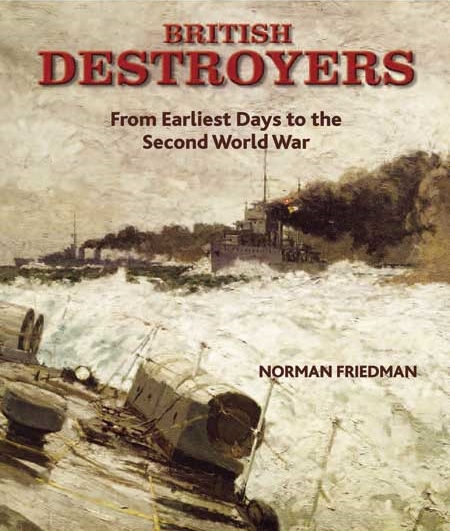
British Destroyers: From Earliest Days to the Second World War. By Norman Friedman. Seaforth Publications, Barnsley, 2009, reprint 2017.
Reviewed by Gregory P. Gilbert
NORMAN FRIEDMAN’S ‘British Destroyers’ was first published in 2009. At the time it was a nice to have technical history but in recent years it has perhaps grown in importance and now this 2017 reprint clearly deserves to be read, or re-read, by all modern naval thinkers. In our present climate of increasing peer power competition, the importance of naval warship survivability is once again at the forefront of our minds. If it is not, then it should be!
Modern warships, especially surface combatants, need to be able to fight and survive at sea. It is no longer acceptable to operate ‘commercial equivalent’ warships or warships built to reduced standards.
Over the last 70 years or so the world’s navies have tended to forget the original ideas behind warship design. The relatively small number of ships that have actually received hits since the end of World War II has led to a, perhaps unconscious, belief that warships no longer need to be designed to fight. Events such as the 1982 Falklands War temporarily reminder us of the importance of survivability but even now many of the lessons learnt from that conflict have been largely forgotten today in the false-compromise of cost reductions. Alternatively many believe that no modern surface combatant needs to be survivable as they will all sink if hit by an anti-ship missile. A similar belief surrounded the widespread use of the torpedo in the early part of the 20th Century however the power of the torpedo was effectively countered during World War I – by making sure that torpedo-boat destroyers could fight and win at sea.
Friedman’s ‘British Destroyers and Frigates: The Second World War and After’ was reviewed by Dr Tim Coyle previously. Readers may ask why is Friedman’s earlier volume ‘British Destroyers: From Earliest Days to the Second World War’ also important. This book not only provides a detailed technical history of the development of British Destroyers during the peak of the Royal Navy’s actual and intellectual power, ‘British Destroyers’ describes how operational thinking established the requirement and subsequent development of the surface combatant.
‘British Destroyers’ discusses the beginnings of the destroyer role in the late 1890s, the development of actual ships which could ‘destroy’ torpedo boats, and how the roles of the destroyer changed during the early 1900s. The development of Admiral Fisher’s destroyers of the mid 1900s, which included the Australian River class, are then discussed. Interesting it was not until just before WWI that a standard destroyer was produced for the RN. Prior to that commercial competition led to significant variations in each destroyer class based upon a set of preliminary specifications laid down by the Admiralty. Commercial practice also led to both good and bad warship design features being introduced and significant operational characteristics between what were meant to be alike ships. The introduction of standard Admiralty design destroyers led to major protests from those commercial warship designers which had invested heavily in design investigations only to find that the Admiralty gave away their improvements to their competition in order to achieve a standard, and invariably better, destroyer.
Friedman then discusses the development of British destroyers during the war, 1914-18, and the lessons absorbed from that experience. Emergency destroyer designs were developed to increase the number of warships available but in practice such ‘rapid development’ programmes tended to not meet their objectives and left the RN with classes of substandard vessels. The Admiralty became obsessed with destroyer numbers and lifetime became the deciding factor for many new builds. They did, however, continue to design new types of destroyers during WWI. These incorporated lessons learnt from actual naval actions, battle damage and weapon capabilities. Interestingly the British V&W Class destroyers of 1918-19 were superior to the United States Navy’s ‘Flush-deck’ equivalents.
Following WWI the Admiralty developed a new standard series of destroyer designs, the A-1 Series – which was the basis for the RN’s inter-war period destroyers. These were destroyers severely limited mostly due to the lack of funds. Relatively few were produced, and new systems – propulsion and weapons – were limited by the lack of research and development funding. By 1935-36 it is fair to say that British destroyers no longer achieved the world’s best practice, The USN had taken the technological lead by the late 1930s. Note the British Tribal class destroyers of the late 1930s are covered in Norman Friedman’s second volume. A large number of the British destroyers build before 1936 continued in service throughout WWII. They were extensively modified, including survivability improvements, and although most were not suitable as fleet destroyers many helped fill the gaps in escort and trade protection work.
This volume also includes a bibliography, extensive notes, a data list (specifications), a list of ships (building dates and fates) as well as an index. It is illustrated with photographs throughout. It includes many ship plans prepared by A.D. Baker III, as well as additional drawings by Alan Raven. Once again Seaforth have produced a fine reference work.
Friedman’s ‘British Destroyers: From Earliest Days to the Second World War’ is a remarkably clear and lucid work on the early development of surface combatants – describing complex and sophisticated development activities in ways that should be understood by any professional or keen amateur. It is both a good read and illuminating. It is a work that helps us understand how modern surface combatants evolved into what they are today and helps us better understand warship design in a world where a sea fight is expected rather than a rare occurrence. ‘British Destroyers’ is highly recommended for the Australian audience.



